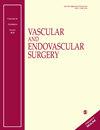糖尿病血液透析患者的前臂远端动静脉瘘成熟度
IF 0.7
4区 医学
Q4 PERIPHERAL VASCULAR DISEASE
引用次数: 0
摘要
目的 糖尿病患者前臂动脉粥样硬化性疾病会阻碍远端瘘管的成熟。本研究旨在观察糖尿病血液透析患者前臂远端(射频消融术或前臂远端)动静脉瘘的成熟情况。患者的详细人口统计学资料、基础疾病、实验室测量、生命体征和手术信息均被记录在案。分别在术后 1 周、1 个月、2 个月和 6 个月前每月检查患者的瘘管发育情况。结果 343 名患者(56% 为男性,44% 为女性,平均年龄:57.32 ± 12.48 岁)中,高血压患者占多数(81.9%),其次是高脂血症(42.3%)和冠心病史(25.9%)。动静脉瘘在 64.98 ± 11.05 天内达到 58.3% 的成熟度;创建期间较高的血压与成功成熟度相关(17.02 ± 1.46 mmHg vs 13.90 ± 1.93 mmHg,P < .05)。男性(57.8%)和女性(58.9%)的前臂远端动静脉瘘成熟度无明显统计学差异(P > .005)。然而,41.7%的动静脉瘘在 18.83 ± 17.89 天内失败。失败的 AVF 在手术和失败期间的血压较低(11.75 ± 1.86 mmHg)。结论糖尿病和患者性别不会影响血液透析患者前臂远端动静脉瘘的成熟时间。术中和术后血压升高与成熟时间缩短有关。本文章由计算机程序翻译,如有差异,请以英文原文为准。
Distal Forearm Arteriovenous Fistula Maturation in Diabetic Hemodialysis Patients
PurposeAtherosclerotic disease of the forearm arteries can impede the maturation of distal fistulas in diabetic patients. The goal of this study was to look at the maturity of diabetic hemodialysis patients’ distal forearm (radiocephalic snuffbox or distal forearm) arteriovenous fistulas.Materials and MethodsPatients with chronic renal failure who were candidates for distal forearm radiocephalic arteriovenous fistula implantation were evaluated in this cross-sectional study. Patients’ demographic details, underlying disorders, laboratory measurements, vital signs, and information on their surgery were all noted. Patients were checked for fistula development 1 week, 1 month, 2 months, and then monthly until 6 months after surgery. Arteriovenous fistula maturation characterized by optimal blood flow, vessel dilation, and structural adaptations.ResultsAmong 343 patients (56% male, 44% female, mean age: 57.32 ± 12.48 years), hypertension prevailed (81.9%), followed by hyperlipidemia (42.3%) and coronary artery disease history (25.9%). AVFs achieved 58.3% maturation in 64.98 ± 11.05 days; higher BP during creation correlated with successful maturation (17.02 ± 1.46 mmHg vs 13.90 ± 1.93 mmHg, P < .05). No significant statistical difference found in distal forearm arteriovenous fistula maturation between males (57.8%) and females (58.9%) ( P > .005). However, 41.7% of AVFs failed in 18.83 ± 17.89 days. Failed AVFs exhibited lower BP during operation and failure (11.75 ± 1.86 mmHg). Kaplan-Meier analysis depicted maturation probabilities over 90 days post-surgery.ConclusionDiabetes and patient sex did not affect the maturation time of distal forearm AVFs in hemodialysis patients. Increased blood pressure during and after surgery correlated with shorter maturation time.
求助全文
通过发布文献求助,成功后即可免费获取论文全文。
去求助
来源期刊

Vascular and Endovascular Surgery
SURGERY-PERIPHERAL VASCULAR DISEASE
CiteScore
1.70
自引率
11.10%
发文量
132
审稿时长
4-8 weeks
期刊介绍:
Vascular and Endovascular Surgery (VES) is a peer-reviewed journal that publishes information to guide vascular specialists in endovascular, surgical, and medical treatment of vascular disease. VES contains original scientific articles on vascular intervention, including new endovascular therapies for peripheral artery, aneurysm, carotid, and venous conditions. This journal is a member of the Committee on Publication Ethics (COPE).
 求助内容:
求助内容: 应助结果提醒方式:
应助结果提醒方式:


